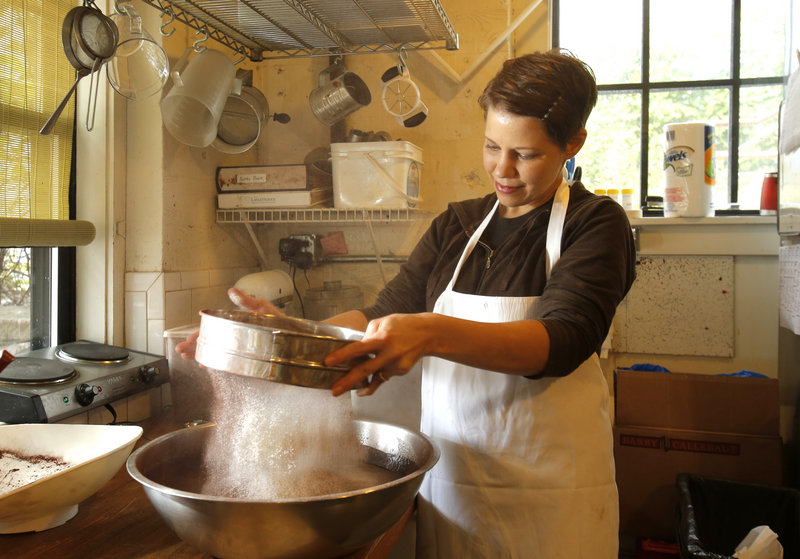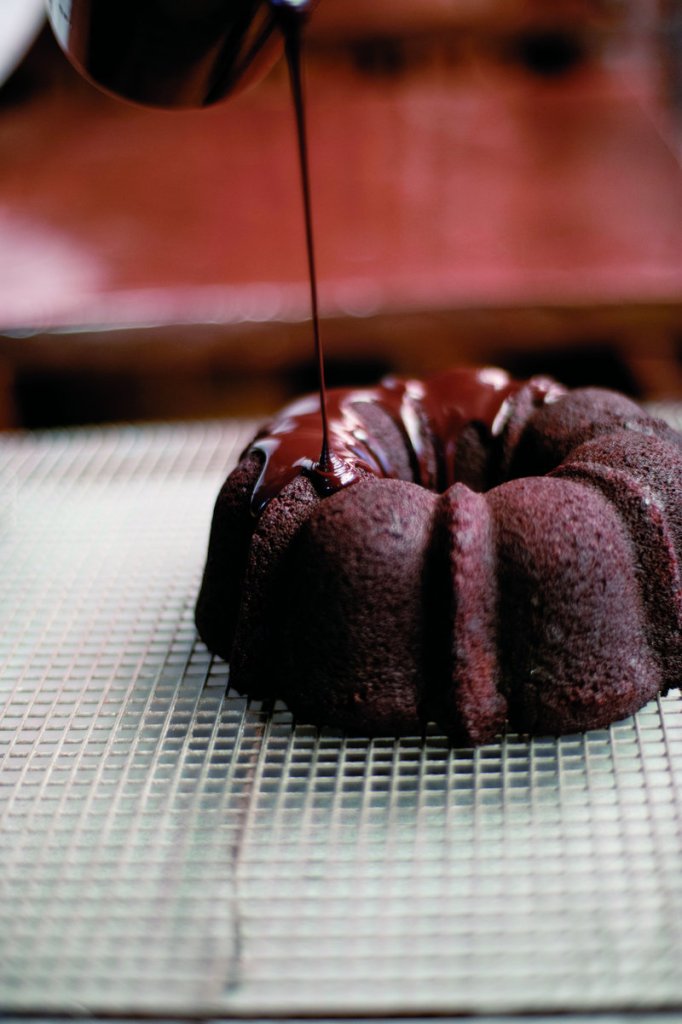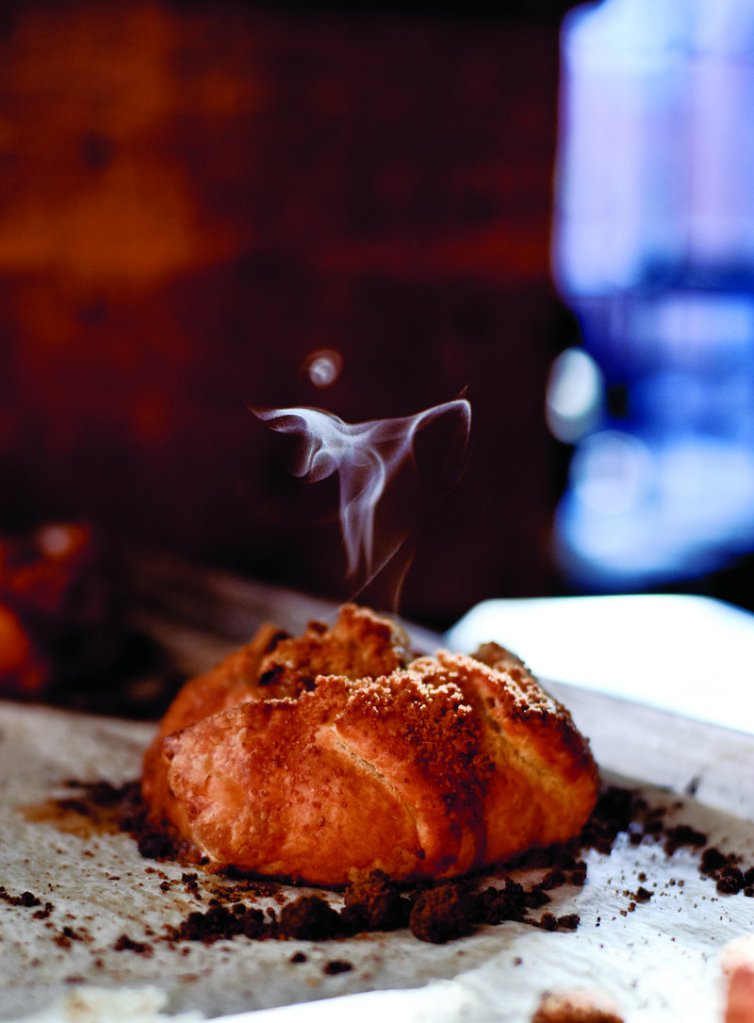It’s harvest time, and this year we have a great crop of local cookbooks that go beyond the usual fare of blueberries and lobster.
Most exciting is the debut cookbook from Standard Baking Co., the Portland bakery that has gotten national raves for its baguettes, croissants and sweet-but-not-too-sweet pastries.
Here’s a first look at the Standard Baking Book, followed by the latest on Maine home cooking from food writer and food historian Sandy Oliver, and a new cookbook featuring nearly 50 Portland restaurants from Margaret Hathaway and Karl Schatz.
•••••
IF YOU’RE A FAN of Standard Baking Co., chances are you’ll do exactly what I did when I first got hold of the bakery’s new pastry book.
I quickly flipped through the pages to see if my favorite Standard Baking treat – the almond raspberry galette – was one of the featured recipes.
There it was, right on page 52.
I could never before envision actually making this round, shortbread-like tart filled with a thin layer of raspberry jam on my own. Its soft, buttery layers crumble in your mouth and transport you to pastry heaven.
So imagine my surprise when I saw that the Standard staff creates this delightful galette from just a handful of simple ingredients – butter, flour, salt, sugar, almond meal, egg and raspberry jam. That’s it.
Alison Pray, who opened Standard Baking with her husband, Matt James, 18 years ago, and Tara Smith give up a lot of secrets in “Pastries,” including the recipes for Standard Baking’s most popular items, croissants and morning buns. Some of the recipes are more intimidating than others – the croissant recipe is five pages long (six if you include the chocolate, ham and cheese, and almond variations).
But Pray says she worked hard to make even the most complicated recipes accessible to the home baker by staying away from technical terms and descriptions that only professionals would understand.
“I’m really hoping that these recipes are written clearly enough that anyone could follow them and understand the process and understand what to look for,” Pray said. “I think that’s the key to getting good results, is having it explained to you: What are you looking for, for the final result? Because there’s a lot of judgment involved in baking: Are these ready to come out of the oven? And what specifically are you looking for?”
Pray said she often gets requests for recipes, but converting measurements from weight to volume, and scaling a recipe down for use at home, is a challenge. Going through these steps for 65 recipes, even more so.
All of those conversions and scaling down of recipes (along with the writing, of course) took two years to complete, but the result is worth it. The thick, almost rustic paper stock, the luscious photography, and the vivid descriptions of what it’s like in the bakery at 3 a.m. make the book as warm and inviting as the bakery itself on a snowy winter’s day.
The photography was done by Sean Alonzo Harris, a longtime bakery employee and fine art photographer who only recently gave up his stint delivering Standard bread around town.
Some of the pastries are sized differently in the book than you’re used to seeing on the bakery’s shelves. The galette in the book, for example, makes an 8-inch tart, while the one you buy on Commercial Street is about three inches.
“If there was something that was hard to source for a home baker, then we changed the recipe so that it would be easier for the home baker to have the right equipment,” Pray said. “We did that with the bread pudding. I think with the financier we gave several options. Also for the chocolate cork, because the mold for the cork that we use is difficult to source. I think in the cork recipe, we suggest using a muffin tin if you can’t source a 2-inch round cylinder.”
Pray agrees that the croissant recipe is probably “the most intimidating recipe in the book,” but even that one should be accessible enough to make at home. She gave her scaled-down recipe to a friend in Massachusetts who is an avid home baker, and let him have at it.
“He was really dying to get his hands on the croissant recipe to try it out, and he did several baking experiments using our instructions,” Pray said. “He had a lot of good feedback, and he had excellent results. So I do feel like it’s written in language that even a beginner home baker could attempt.”
Overall, Pray says she hopes the book “conveys a feeling of our attitude about our work and the enjoyment we take in it.”
Yes, it does, but if you’re considering picking this book up, be careful: As you read it, you’ll start to have intense cravings for morning buns.
Don’t say I didn’t warn you.
“STANDARD BAKING CO. PASTRIES” by Alison Pray and Tara Smith (Down East Books, $29.95). Publication date Oct. 15. Available now for preorder on Amazon.com
FOR MORE of my conversation with Alison Pray, and to get the recipe for Molasses Spice Cookies, click here.
•••••
SANDY OLIVER says she is “sick and tired” of hearing that nobody cooks anymore.
“People do too cook,” she said in an interview from her home on Islesboro. “They don’t think they’re cooking, but they are cooking. Between the big, glossy food magazines, and the food channel and other kids of things, not to mention advertising – advertising constantly tries to shoot down home cooking because they want you to buy premade products – everyone’s got this idea that nobody’s cooking anymore. Well, maybe they aren’t in New York, but they sure are in Maine.”
Oliver’s new book, “Maine Home Cooking,” is full of evidence that Mainers are, indeed, spending time in their kitchens. It’s just that the definition of cooking has changed.
People don’t think that throwing a chicken in the oven to roast and serving it with a side of potatoes is cooking anymore, Oliver argues. They think they have to deglaze the pan and make a fancy, chef-worthy sauce as well.
Oliver’s new book contains recipes for simple foods cooked simply, like baked bean soup and haddock casserole. Oliver includes all the classic Down East dishes (lobster stew, tourtiere, brown bread) as well as a chapter on seasonal foods (crispy kale chips, strawberry spinach salad) and one on preserving the harvest (dilly green beans, pickled beets).
Oliver brings us into her 19th-century home and her rustic kitchen, which hasn’t changed much since the 1940s. We see what’s in her own pantry, and read about what she grows in her 2,000-square-foot garden.
The book is laced with Oliver’s feisty sense of humor, as well as historical tidbits that explain the origins of dishes such as chess cake and finnan haddie. Most of the recipes came from readers of Oliver’s food column in the Bangor Daily News; others are recipes she’s asked for when she’s tasted a dish she loved at a potluck or other community gathering.
Yes, a prolific cook like Oliver has a million recipes for dishes like blueberry pie, but she didn’t have to test every single one to know which ones she wanted to include in the book.
“Some of them I’m dead certain on because I make them all the time,” she said. “They’re my favorite ways of fixing blueberry pie, for example, or this is the crisp I always use for everything, I don’t care what kind of crisp it is. Or this is how I always make finnan haddie. This is how I always do lobster stew.”
Oliver hopes that her new book will teach people that they need to cook to please themselves, not the Food Network or Bon Appetit, and to remember that there is often no right or wrong way to prepare a dish.
“A lot of recipes are extremely elastic,” she said. “There’s not going to be anybody coming in and reviewing your dinner and putting it in the paper and giving it three stars. You only have to please yourself and your family.”
“MAINE HOME COOKING: 175 RECIPES FROM DOWN EAST KITCHENS” by Sandra L. Oliver (Down East Books, $29.95). Published Sept. 1
•••••
MARGARET HATHAWAY was as surprised as I was to discover that the nearly 50 Portland restaurants she profiled in her new book were all located right on the peninsula – and all are within walking distance of each other.
If there were ever any doubts about how spoiled Portlanders are when it comes to access to good restaurants, “Portland, Maine Chef’s Table” will erase them. Not only are the restaurants in this city incredibly abundant, they are also mostly chef-driven and serving local foods.
“The craziest thing was that pretty much everyone does” focus on local foods, Hathaway said. “At some point with the head notes, you feel like you’re being repetitive: ‘Local foods from the chef’s own farm.’ A good five or six restaurants, the chefs were the actual farmers.”
Karl Schatz, Hathaway’s husband (and partner in Ten Apple Farm, where they raise dairy goats), took the photographs for the book.
The fun thing about a book like this is learning little tidbits about local chefs. Steve Tuggle, the chef at Taco Escobarr, for example, used to be personal chef to several of the Green Bay Packers. Who knew?
Then there’s the pleasure of seeing how the chefs make some of your local favorites. The guys from Otto Pizza, for example, explain how to make their famous mashed potato, bacon and scallion pizza, and the brothers who own Emilitsa give up their moussaka recipe.
Some of the offerings appear a little out of reach for the casual home cook, even though Hathaway tested many of them with friends who love to spend time in the kitchen. A Figa recipe, for one of its most popular dishes, calls for a wild boar shoulder. And how many people have the sausage stuffer that’s need to make Grace’s Coast of Maine Cassoulet? Nevertheless, it’s entertaining to read about how the chefs prepare these dishes. (And Figa chef Lee Farrington says you can substitute beef for that wild boar.)
Hathaway says she loved learning about the chefs and hearing their stories about how they named their restaurants or fixed them up.
“People have such love and heart that goes into naming their restaurants and creating the space. I love that,” she said. “When you meet them, you wouldn’t think they have this very tender side. It makes me want to go to these restaurants and support them even more because there are real people and real families attached to them.”
The couple also noted that none of the chefs bad-mouthed any of their colleagues during the production of the book, which is something you might expect to hear in a larger city. The environment in Portland is more collaborative; the competition is friendly, not cutthroat.
Schatz said he thinks it is, in a way, a reflection of the city.
“I think part of the reason so many of these restaurants have been able to succeed is they have customers who get that feeling when they’re at the restaurants,” he said. “It’s not just good food, it’s good feeling.”
“PORTLAND, MAINE CHEF’S TABLE: EXTRAORDINARY RECIPES FROM CASCO BAY” by Margaret Hathaway (Lyons Press, $24.95). Published Aug. 21
Staff Writer Meredith Goad can be contacted at 791-6332 or at: mgoad@pressherald.com
Twitter: MeredithGoad
Send questions/comments to the editors.








Comments are no longer available on this story